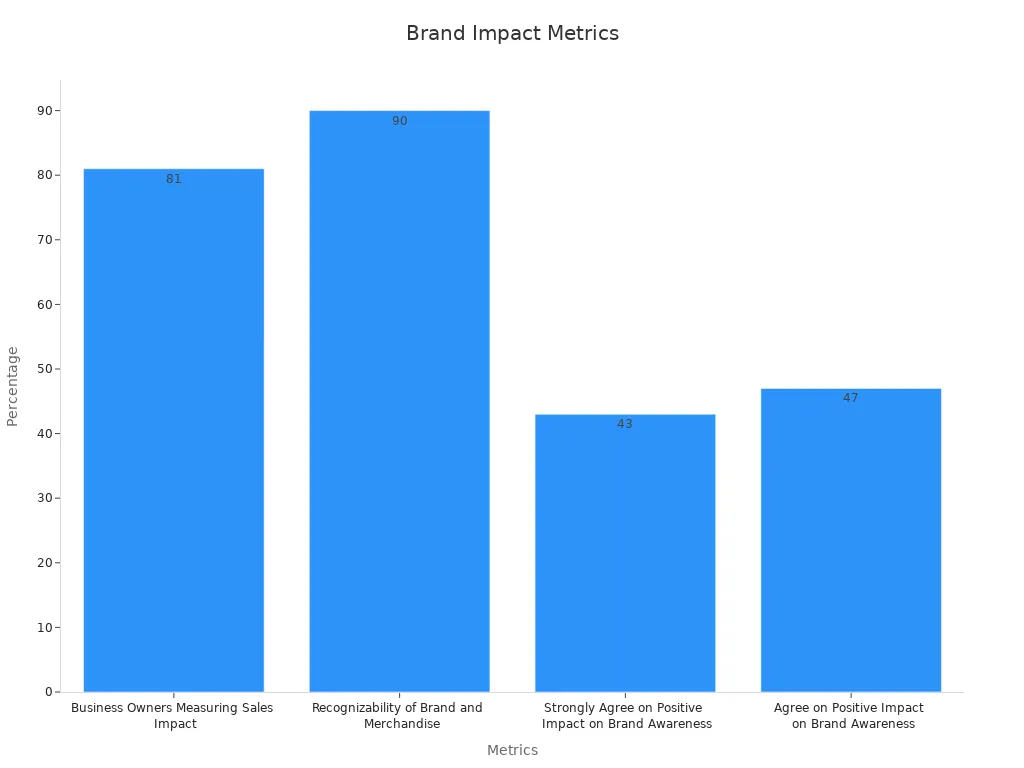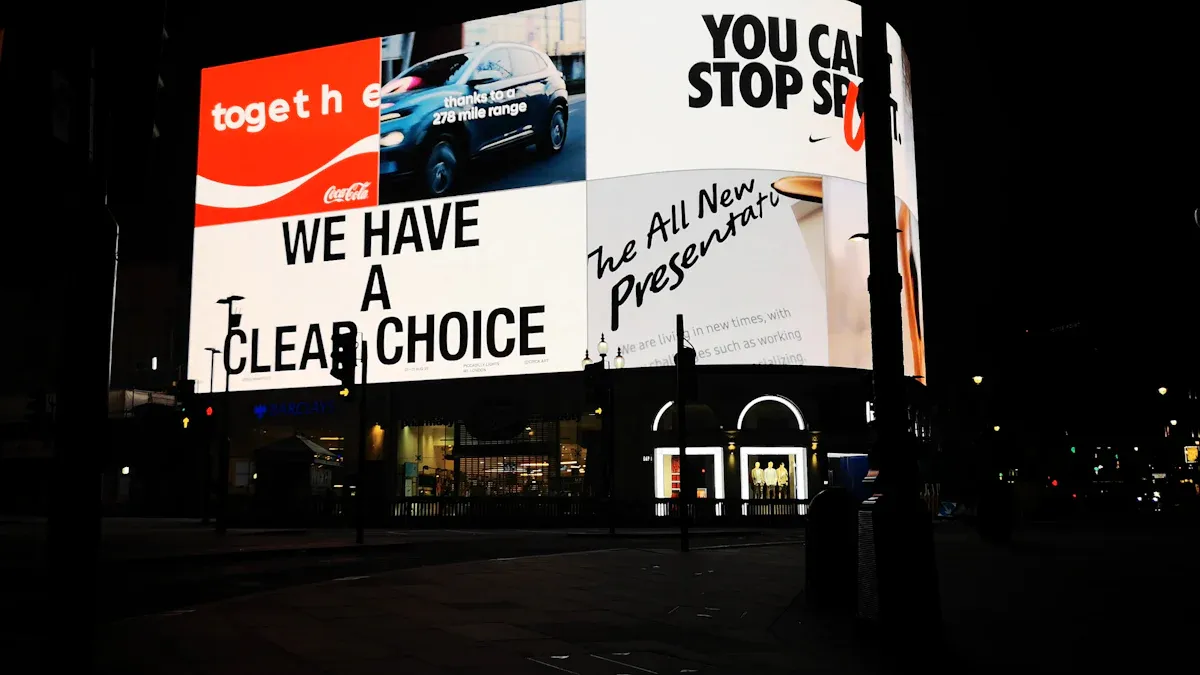Digital Signage ROI and its business impact

Digital signs change how businesses connect with customers and significantly enhance Digital Signage ROI. They show clear results that help businesses succeed. For example:
64% of businesses using digital signs see more customer interest.
84% of stores notice better brand recognition.
This tech makes customers happier by 46% and raises sales by 32%.
Moving displays bring in 24% more visitors.
76% of shoppers check out stores they’ve never been to.
Using digital signs can grow sales, improve customer interest, and make a big difference in your business's success, ultimately boosting your Digital Signage ROI.
Key Takeaways
Digital signs grab attention 64% more and boost sales 32%. Use them to bring in more customers and grow your business.
Checking ROI helps businesses make smart choices. Set clear goals and track things like sales and customer interest to improve your digital sign plan.
Digital signs make people remember your brand 84% better. Use bright pictures and fun content to make your brand stand out and connect with people.
Digital signs make work easier, cutting questions by 42% and saving up to $3.2 million a year. Share info faster and focus on bigger tasks.
Update your content often and use data to improve your plans. This keeps your digital signs fresh and interesting, giving you better results.
Understanding Digital Signage ROI
What is ROI in digital signage?
ROI, or Return on Investment, shows how much profit you make compared to what you spend. For digital signage, it checks how well your screens help with goals like more sales, better customer interaction, or smoother operations. Unlike old-school ads, digital signage ROI looks at both direct and indirect gains. For example:
Type of Metric | Digital Signage | Traditional Ads |
|---|---|---|
Focus of Measurement | Both direct and indirect benefits | Only quick money returns |
Engagement Tracking | Customer actions, efficiency | Just passive views |
Data Collection | Active (touch, voice) and passive (camera) | Mostly basic impressions |
Key Numbers | Time spent, session counts | Often lacks detailed tracking |
Digital signage gives a smarter way to measure success. With advanced tools, you can track customer actions, time spent, and even sales, giving a clearer view of how your investment pays off.
Why ROI matters for businesses
Knowing ROI helps businesses make smart choices about spending. Measuring digital signage ROI shows what works and what doesn’t, so you can use your money wisely. Here’s why it’s important:
Custom Plans: ROI tracking changes by industry, letting you adjust for the best results.
Clear Goals: Setting goals makes sure your signage fits your business plans.
Better Decisions: Checking ROI data helps improve strategies and boost results.
For example, tracking sales growth and cost savings shows how digital signage helps your profits. Businesses that look at both numbers and customer feedback get a full picture of their success.
Using digital signage to boost ROI
Digital signage isn’t just a screen; it’s a smart tool for results. Many businesses use it to achieve big wins. Here are some examples:
Use Case | What It Does |
|---|---|
Special Deals | Shows exciting visuals for limited-time offers with clear actions. |
Product Demos | Displays product features through videos, making people curious to learn. |
Customer Reviews | Shares real reviews with visuals, encouraging people to explore more. |
Smart Placement | Puts signs in busy spots to grab attention. |
Interactive Features | Lets customers play games or take surveys on touchscreens. |
Content Improvements | Uses data to adjust content for better sales and engagement. |
For instance, McDonald’s used digital menus to improve orders and upselling, while Adidas increased sales at events with live marketing. These examples show how digital signage can improve customer experiences and grow ROI.
Also, stats prove its power. Businesses see a 124% profit rise and a 7% sales jump after using digital signage. These results show that digital signage is a great way to increase ROI.
Business Benefits of Digital Signage

Increased Sales and Revenue
Digital signs help stores sell more by influencing shoppers. McDonald's made $75,000 to $225,000 more each year, with sales rising 10% to 30%. Best Buy saw a 7% sales boost for featured items. H&M increased sales by 22% with live fashion shows. Walmart's pharmacy earned 5% more by showing clear service info.
Company | Sales Increase | Description |
|---|---|---|
McDonald's | 10% to 30% | Digital signs added $75,000 to $225,000 in yearly revenue. |
Best Buy | 7% | Signs taught customers, raising sales of featured products by 7%. |
H&M | 22% | Live fashion shows on signs boosted sales by 22%. |
Walmart | 5% | Pharmacy signs improved service visibility, increasing sales by 5%. |
These examples show how digital signs grab attention and boost sales by sharing eye-catching, targeted messages.
Enhanced Customer Engagement
Moving content on digital signs grabs attention and gets people involved. Studies show digital signs get 400% more views than still images. Metrics like foot traffic and time spent watching help businesses improve sign placement and content. For instance, Coca-Cola’s Times Square billboard let people design virtual Coke bottles, boosting brand loyalty. Sephora uses signs to teach shoppers about products, creating stronger connections and repeat buyers.
Metric | Description |
|---|---|
Foot Traffic | Counts how many people pass by, helping decide where to place signs. |
Dwell Time | Tracks how long people watch, showing if the content is interesting. |
Viewer Demographics | Gives details about the audience, helping create content they like. |
Engagement Rate | Measures how much people interact with the signs, guiding better strategies. |
Using these tools, businesses can make custom experiences that build trust and increase sales.
Operational Efficiency
Digital signs make work easier by cutting down on tasks and questions. Businesses report 42% fewer questions and save 68% on labor hours for managing info. This can save up to $3.2 million a year, with 6,300 fewer daily questions. These savings let teams focus on more important work.
Metric | Value |
|---|---|
Reduction in information-related inquiries | 42% |
Annual operational cost savings | $3.2M |
Reduction in labor hours for information management | 68% |
Daily inquiries reduced | 6,300 |
Digital signs also replace printed materials, saving money and helping the environment. By automating tasks and improving communication, businesses save time and money while working more efficiently.
Brand Awareness and Recognition
Digital signs help people notice and remember your brand. They make your business stand out in crowded markets. Showing exciting and moving content keeps your brand fresh in customers' minds.
Studies show digital signs improve how people see your brand. For example:
Metric | Percentage |
|---|---|
Business Owners Seeing Sales Growth | 81% |
Brand and Product Recognition | 90% |
Strongly Agree on Brand Awareness Boost | 43% |
Agree on Brand Awareness Boost | 47% |
These numbers prove digital signs make your brand stronger and connect better with people. Bright pictures, videos, and fun features help customers trust and like your brand.

Digital signs let you change messages for different groups of people. You can promote holiday items or show what makes your business special. This helps people notice your brand and buy more.
Tip: Share your brand’s story, values, and wins on digital signs. This builds trust and makes people feel closer to your brand.
Using digital signs wisely can grow your brand and leave a strong impression. Whether you own a store, restaurant, or service, digital signs are a great way to boost your brand’s image and recognition.
Measuring Digital Signage ROI
Setting Goals and Tracking Progress
To see how well your digital signs work, set clear goals and track progress. Goals help you focus on what matters most for your business. Decide if you want to boost sales, get more customer attention, or make work easier. After setting goals, pick simple ways to measure success, like numbers or percentages.
Here are some common ways to measure digital sign success:
Metric Type | Operational Goals | Financial Goals |
|---|---|---|
Content Success | Screen Working Time: 99% | ROI from Signs: 120% average |
Customer Interaction | Update Content Weekly | Revenue Growth: 15% yearly |
For example, if you want happier customers, check survey answers or how many come back. Use industry averages to set fair targets:
Key Metric | Industry Average | Target for Digital Signs |
|---|---|---|
Customer Happiness Score | 80-90% | 85%+ |
Survey Answer Rate | 30-40% | 35%+ |
Returning Customers | 70% | 75%+ |
By setting clear goals and tracking them, you can see how well your digital signs are helping your business.
Important Numbers to Watch
Watching the right numbers shows how well your digital signs are working. These numbers tell you what’s going well and what needs fixing. Focus on these areas:
Metric | What It Shows |
|---|---|
Customer Interaction | Time spent watching, clicks, and views show how much people like your signs. |
Sales and Money | Tracks how signs help sell more and make more money. |
Work Efficiency | Shows how signs save time and cut costs. |
Brand Awareness | Measures how well people remember and like your brand. |
Customer Happiness | Surveys and feedback show how signs improve customer experience. |
For instance, checking how long people watch your signs shows if your content is interesting. Sales data can show if signs help people buy more. Work efficiency numbers, like screen uptime, show how signs save time and money.
Use tools like software to track viewers, QR codes for campaigns, or sales systems to collect data. These tools give real-time info to help you improve your signs and get better results.
Tools to Measure Success
Using the right tools helps you see how well your digital signs work. Each tool gives different insights to improve your strategy. Here’s a look at some popular tools:
Tool/Method | What It Does |
|---|---|
Sales Data | Compares sales before and after using signs to see revenue changes. |
Customer Feedback | Collects opinions to learn how signs affect shopping experiences. |
Foot Traffic Tracking | Uses sensors or cameras to count people near your signs. |
For example, sales data shows how much money your signs bring in. Customer surveys tell you if people like the signs. Foot traffic tracking shows if signs are placed in the best spots.
Advanced tools, like software to measure viewing time, can give even more details. QR codes or special links track how well specific campaigns work. Social media tools can also show how signs affect online activity.
By using these tools together, you get a full picture of your digital signs’ success. This helps you make smart choices and get the most out of your investment.
Overcoming ROI Measurement Challenges
Understanding hard-to-measure benefits
Digital signage often brings benefits that are hard to measure. These include brand awareness, customer happiness, and employee motivation. While these don’t always show up as numbers, they still help your business succeed.
Here’s how to handle these challenges:
Ask customers through surveys how signs improve their shopping experience.
Get employee opinions to see if internal signs work well.
Share stories and reviews to show positive results from digital signage.
For example, a digital sign in the right spot can make customers happier by showing clear directions or special deals. Even if the money impact isn’t instant, better loyalty and brand image help your business in the long run.
Tip: Look at feedback from customers and employees often. This helps you see how digital signage affects your business overall.
Steps for better measurement
To measure Digital Signage ROI well, follow a clear plan. Start by picking key goals like more customer visits or higher sales. Then, use the right tools to track these goals.
Try these ideas:
Match your goals with specific KPIs, like sales or foot traffic.
Mix surveys with tools that track numbers, like sales reports.
Compare the cost of signs with the money they help you earn.
These steps give you a better idea of how digital signage helps your business grow.
Using data and feedback
Data and feedback are important for checking how well digital signage works. Surveys and interactive tools can show what customers like and how they act.
Here’s what you can do:
Use surveys or forms to ask customers for their thoughts.
Check numbers like time spent watching signs to improve content.
Watch how viewers feel about your signs to make them better.
For example, if data shows customers enjoy interactive displays, focus on making more of those. Using this information keeps your signs useful and interesting.
Note: Change your content often based on data to keep customers engaged and improve results.
Maximizing ROI with Digital Signage

Best practices for content optimization
Making your digital signage work well helps you get better results. First, know who your audience is and create messages they like. Assign people to manage the screens and keep branding consistent. Use moving pictures and animations to catch attention. Add touchscreens to make signs more interactive and fun.
Clear text is very important for success. Pick fonts and sizes that are easy to read on all screens. Connect your signs to apps like social media or inventory systems using APIs. Schedule updates automatically to keep your content fresh and useful. This helps your campaigns show results quickly.
Check how your signs are doing by tracking numbers like views and time spent watching. For example, if people don’t watch for long, your visuals might need changes. Following these tips can make your digital signage more effective and boost your results.
Using analytics to refine strategies
Analytics help you improve your digital signage by showing what works. Look at how people interact with your signs and use that data to make better choices. Numbers like clicks, time spent, and audience details show what people enjoy most.
Using this information lets you share content that fits your audience. For example, if weekend promotions get more clicks, plan similar campaigns for busy times. This way, your signs match customer habits and work better.
A study says digital signage will grow to $31.71 billion by 2028. This shows how important it is to use analytics to improve your signs and get better results.
Aligning digital signage with business goals
Connecting your digital signs to your business goals makes them more useful. Start by setting clear goals, like selling more during holidays or helping employees work better. Put signs in busy areas to get more attention and encourage quick purchases.
For example, stores can use digital signs to make shopping easier and earn extra money. This helps your signs fit into your overall business plan.
Example Goal | Description |
|---|---|
Implementing Displays | "We will add two digital signs in busy store areas." |
By matching your signs with your business goals, you can see quick results and grow over time.
Digital signage helps businesses grow by showing clear results. It boosts sales, gets customers more involved, and makes work easier. It also helps people notice and remember your brand. By learning how it works and checking its ROI, you can use it better. Following smart tips makes sure your digital signs match your goals and bring good results. Using this technology can help your business succeed for a long time. With a good plan, digital signage can become a strong tool for growth.
Tip: Check your digital signage plan often to keep doing well.
FAQ
Which industries gain the most from digital signage?
Retail, hotels, hospitals, and schools benefit a lot. Digital signage helps sell products, share updates, or engage people. For instance, stores use it for deals, and hospitals use it to inform patients.
How do you check if digital signage works well?
Look at numbers like sales increases, customer interest, and work savings. Use tools such as tracking software, surveys, or people counters. These tools show how effective your signage is.
Is digital signage costly to set up?
Prices depend on the screens, software, and setup. Start small with low-cost options like simple software and basic screens. Add more as you see good results.
Can small businesses use digital signage?
Yes, small businesses can use it to attract buyers and show deals. Budget-friendly systems, like easy plug-and-play setups, make it simple to start.
How does digital signage help the environment?
It cuts down on paper by replacing printed signs. You can update content quickly without using extra materials. This makes it an eco-friendly choice for businesses.
Tip: Pick screens that save energy to lower your impact even more.
See Also
Maximizing ROI Through Effective Digital Signage Solutions
Enhancing Customer Engagement With Digital Display Signage
Exploring Digital Signage Displays: Benefits And Implementation Techniques
The Role of Digital Signage Technology in Communication
Top Digital Signage Displays: Applications And Benefits For 2025

